
Church of St. George, from 12th century, rebuilt in 15th century. (645k)
From the Istria entry in Wikipedia:
Istria is the largest peninsula within the Adriatic Sea. The peninsula is located at the head of the Adriatic between the Gulf of Trieste and the Kvarner Gulf. It is shared by three countries: Croatia, Slovenia, and Italy. Croatia encapsulates most of the Istrian peninsula with its Istria County.
The name is derived from the Histri tribes, which Strabo refers to as living in the region and who are credited as being the builders of the hill fort settlements (castellieri). The Histri are classified in some sources as a "Venetic" Illyrian tribe with certain linguistic differences from other Illyrians. The Romans described the Histri as a fierce tribe of pirates, protected by the difficult navigation of their rocky coasts. It took two military campaigns for the Romans to finally subdue them in 177 BCE. The region was then called together with the Venetian part the X. Roman Region of "Venetia et Histria", the ancient definition of the northeastern border of Italy. Dante Alighieri refers to it as well, the eastern border of Italy per ancient definition is the river Arsia. The eastern side of this river was settled by people whose culture was different than Histrians. Earlier influence of the Iapodes was attested there, while at some time between the 4th and 1st century BCE the Liburnians extended their territory and it became a part of Liburnia. On the northern side, Histria extended much further north and included the Italian city of Trieste.
In the Dark Ages, Istria was conquered and occupied by the Goths. Ostrogoth coins were found in Istria, as well as the remains of some buildings. South of Poreč there are the remains of the church of Sv. Petar, erected in the 5th century (with a baptistery added later), which reportedly served the Arian eastern Goths ruling Istria. Most notably, the Goths used Istrian stone to build their best known monument, the Mausoleum of Theodoric in Ravenna. In the following centuries, the peninsula was attacked and conquered by the Lombards, often in conjunction with the Slavs, such as in 601. However, the extent to which the Lombards occupied Istria is a matter of debate. After the Goths, Istria became part of the Exarchate of Ravenna. Gulfaris, who served the Byzantines but was of Lombard descent, is reported as its dux in 599.
Pope Gregory I in 600 wrote to bishop of Salona Maximus in which he expresses concern about arrival of the Slavs, "Et quidem de Sclavorum gente, quae vobis valde imminet, et affligor vehementer et conturbor. Affligor in his quae jam in vobis patior; conturbor, quia per Istriae aditum jam ad Italiam intrare coeperunt" (And as for the people of the Slavs who are really approaching you, I am very depressed and confused. I am depressed because I sympathize with you, confused because they over the Istria began to enter the Italy) After the fall of the Western Roman Empire, the region was pillaged by the Goths, the Eastern Roman Empire, and the Avars. It western part was subsequently annexed to the Lombard Kingdom in 751, and then annexed to the Frankish kingdom by Pepin of Italy in 789. In 804, the Placitum of Riziano was held in the Parish of Rižan (Latin: Risanum), which was a meeting between the representatives of Istrian towns and castles and the deputies of Charlemagne and his son Pepin. The report about this judicial diet illustrates the changes accompanying the transfer of power from the Eastern Roman Empire to the Carolingian Empire and the discontent of the local residents.
Afterwards it was successively controlled by the dukes of Carantania, Merania, Bavaria and by the patriarch of Aquileia, before it became the territory of the Republic of Venice in 1267. The medieval Croatian kingdom held only the far eastern part of Istria (the border was near the river Raša), but they lost it to the Holy Roman Empire in the late 11th century.
The coastal areas and cities of Istria came under Venetian Influence in the 9th century. On 15 February 1267, Parenzo was formally incorporated with the Venetian state. Other coastal towns followed shortly thereafter. Bajamonte Tiepolo was sent away from Venice in 1310, to start a new life in Istria after his downfall. A description of the 16th-century Istria with a precise map was prepared by the Italian geographer Pietro Coppo. A copy of the map inscribed in stone can now be seen in the Pietro Coppo Park in the center of the town of Izola in southwestern Slovenia.
The Inner part of Istria around Mitterburg (Pazin) had been part of the Holy Roman Empire for centuries, and more specifically part of the domains of the Austrian Habsburgs since the 14th century. In 1797, with the Treaty of Campo Formio, the Venetian parts of the peninsula also passed to the Habsburg monarchy which became the Austrian Empire in 1804.
Following the Austrian defeat by Napoleon during the War of the Third Coalition, Istria became part of the Napoleonic Kingdom of Italy (1806–1810) following the Peace of Pressburg, and then part of the Illyrian provinces of the French Empire (1810–1813) after the Treaty of Paris.
After this seven-year period, the Austrian Empire regained Istria, which became part of the constituent Kingdom of Illyria. This kingdom was broken up in 1849, after which Istria formed part of Austrian Littoral, also known as the "Küstenland", which also included the city of Trieste and the Princely County of Gorizia and Gradisca until 1918. At that time the borders of Istria included part of what is now Italian Venezia-Giulia and parts of modern-day Slovenia and Croatia, but not the city of Trieste.
Many Istrian Italians looked with sympathy towards the Risorgimento movement that fought for the unification of Italy. However, after the Third Italian War of Independence (1866), when the Veneto and Friuli regions were ceded by the Austrians to the newly formed Kingdom Italy, Istria remained part of the Austro-Hungarian Empire, together with other Italian-speaking areas on the eastern Adriatic. This triggered the gradual rise of Italian irredentism among many Italians in Istria, who demanded the unification of Istria with Italy. The Italians in Istria supported the Italian Risorgimento: as a consequence, the Austrians saw the Italians as enemies and favored the Slav communities of Istria, fostering the nascent nationalism of Slovenes and Croats.
During the meeting of the Council of Ministers of 12 November 1866, Emperor Franz Joseph I of Austria outlined a wide-ranging project aimed at the Germanization or Slavization of the areas of the empire with an Italian presence.
After World War I and the dissolution of Austria-Hungary, there was a strong local movement toward Istrian independence but in the end Istria was partitioned to Italy in the Treaty of Rapallo (1920).
Istria's political and economic importance declined under Italian rule, and after the fascist takeover of Italy in 1922 the Italian government began a campaign of forced Italianization. In 1926, use of Slavic languages was banned, to the extent that Slavic family names were ordered to be changed to suit the fascist authorities.
The organization TIGR, founded in 1927 by young Slovene liberal nationalists from Gorizia region and Trieste and regarded as the first armed antifascist resistance group in Europe soon penetrated into Slovene and Croatian-speaking parts of Istria.
In World War II, Istria became a battleground of competing ethnic and political groups. Istrian nationalist groups which were pro-fascist and pro-Allied and Yugoslav-supported pro-communist groups fought with each other and the Italian army. After the German withdrawal in 1945, Yugoslav partisans gained the upper hand and began a violent purge of real or suspected opponents in an "orgy of revenge".
After the end of World War II, Istria was ceded to Yugoslavia, except for a small part in the northwest corner that formed Zone B of the provisionally independent Free Territory of Trieste; Zone B was under Yugoslav administration and after the de facto dissolution of the Free Territory in 1954 it was also incorporated into Yugoslavia. Only the small town of Muggia, near Trieste, being part of Zone A remained with Italy.
The events of the period are visible in Pula. The city had an Istrian Italians majority and is located on the southernmost tip of the Istrian peninsula. Between December 1946 and September 1947, a large proportion of the city's inhabitants were forced to emigrate to Italy. Most of them left in the immediate aftermath of the signing of the Paris Peace Treaty on February 10, 1947 which granted Pula and the greater part of Istria to Yugoslavia.
The division of Istria between Croatia and Slovenia runs on the former republic borders, which were not precisely defined in the former Yugoslavia. Various points of contention remain unresolved between the two countries regarding the precise line of the border.
All pictures are © Dr. Günther Eichhorn, unless otherwise noted.
From the Lovran entry in Wikipedia:
Lovran is one of the oldest coastal settlements on the eastern shore of Istrian peninsula. According to one legend, the town was created when the Roman patrician and statesman Marcus Vipsanius Agrippa built his summer residence on the site in the first century CE. By the early Middle Ages it was an important urban and shipbuilding center of northern Adriatic. Following the sudden development of port towns in the vicinity (Trieste, Pula, and Rijeka) which became the new and dominant urban centers in the region, Lovran lost its significance.
However, by the mid 19th century, the area gains prominence as it becomes a fashionable resort for the Austro-Hungarian nobility. The long tradition of tourism is still strongly felt in the Lovran region, and it forms the backbone of the economy.





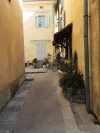

From the Hum, Croatia entry in Wikipedia:
On its western side, the town is enclosed by walls and on the remaining sides houses are built into the defensive walls. It was first mentioned in documents dating from 1102, at which time it was called Cholm which is derived from the Italian name Colmo. A bell and watch tower was built in 1552 as part of the town's defenses beside the town loggia.
The town's parish church of the Assumption of Mary, with its classical facade was built in 1802 on the site of an earlier church which was built by the local master Juraj Gržinić.
The "Hum Glagolitic wall writings" are preserved in the church, written in the formative period of Glagolitic (the second half of the 12th century) and they are one of the oldest examples of Croatian Glagolitic literary culture in the Middle Ages. The town's museum displays a few Glagolitic writings.



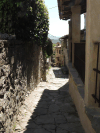


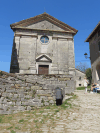



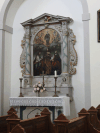


From the Motovun entry in Wikipedia:
Motovun is a village and a municipality in central Istria, Croatia. In ancient times, both Celts and Illyrians built their fortresses at the location of present-day Motovun. The name of the village is also of Celtic origin, derived from Montona, meaning "a town in the hills".
Motovun is a medieval town that grew up on the site of an ancient city called Castellieri. In the 10th and 11th centuries it belonged to the Bishop of Poreč. From 1278 it was taken over by Venice and surrounded by solid walls which are still intact today. The three parts of the town are connected by a system of internal and external fortifications with towers and city gates containing elements of Romanesque, Gothic and Renaissance styles, built between the 14th and 17th centuries. It is a typical example of Venetian colonial architecture.







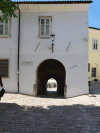

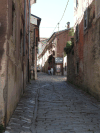




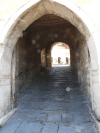
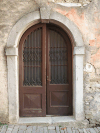

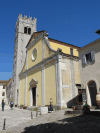






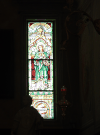
From the Rovinj entry in Wikipedia:
Rovinj is a city in Croatia situated on the north Adriatic Sea. Rovinj was already a settlement of Venetian or Illyrian tribes before being captured by the Romans, who called it Arupinium or Mons Rubineus, and later Ruginium and Ruvinium. Built on an island close to the coast, it became connected to the mainland much later, in 1763, by filling in the channel.
Rovinj was eventually incorporated into the Byzantine Empire, later becoming part of the Exarchate of Ravenna in the 6th century, before being taken over by the Frankish Empire in 788. For the following several centuries it was ruled by a succession of feudal lords, and in 1209 it was acquired by the Patriarchate of Aquileia under Wolfger von Erla.
From 1283 to 1797 Rovinj was one of the most important towns in Istria governed by the Republic of Venice. During this period three town gates were constructed and Rovinj was fortified by two rows of defensive walls, remains of which can still be seen today.
Following the fall of Venice in 1797 and the ensuing Napoleonic interlude, Rovinj became part of the Austrian Empire, which lasted until World War I.
It then belonged to Kingdom of Italy from 1918 to 1947, when it was ceded to SFR Yugoslavia, as part of SR Croatia.









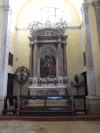


This page contains 57 pictures

Main page for Hrvatska (Croatia)
Page last updated on Fri Dec 2 11:23:19 2022 (Mountain Standard Time)
Istria Peninsula on gei.guenther-eichhorn.com